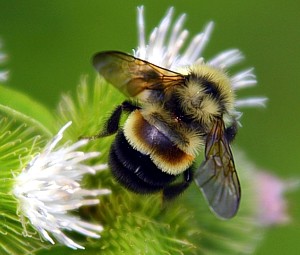 Rusty patch bumble bee. Photo by Headline & Global News.
Rusty patch bumble bee. Photo by Headline & Global News.
While most people don’t give much thought, if any, to how important bees are to our lives by pollinating some of our most basic fruits, vegetables, and grains. Activists are taking notice and making efforts to stop their declining numbers in the wild from threats including habitat destruction, pesticides, and pathogens.
To really understand the important role of bees, Achim Steiner, United Nations Environment Programme (UNEP) Executive Director, says of “the crop species that provide 90 percent of the world’s food, over 70 are pollinated by bees.”
In the United States, conservation groups are currently trying to protect the rusty patch bumble bee, which is an important pollinator of crops including tomatoes, apples, cranberries, blueberries, and alfalfa.
Last year, the Xerces Society for Invertebrate Conservation together with the Natural Resources Defense Council filed a petition with the U.S. Department of the Interior and the U.S. Fish and Wildlife Service to have the rusty patch bumble bee considered for protection under the Endangered Species Act.
The conservation groups explained that among the reasons this particular bee is important is because of its ability to buzz pollinate, which means that the vibrations or buzzing from its wings dislodge plant pollen and facilitate the fertilization process.
A number of our staple foods such as the tomatoes, peppers, potatoes, eggplants, blueberries, and cranberries can only be fertilized through buzz pollination, and there are very few types of bees can do this kind of pollination.
Honeybees don’t buzz pollinate, and the San Francisco online magazine Bay Nature explains that many of the plants that do produce these staples crops “do not produce nectar, so honeybees ignore them anyway.”
Bay Nature adds that while “bumble bees and other native bees were long ignored by farmers because they produce little or no honey and don’t form large, portable colonies like honeybees,” they are starting to be recognized for their role as “important crop pollinators, especially in these times of declining honeybee populations.”
And, honeybees aren’t the only ones on the decline. Xerces explains that the rusty patch bumble bees – whose range historically spread across the eastern United States from southern Maine to Georgia and west into states including Minnesota, Wisconsin, Ohio, Indiana, and North Dakota – have lost more than 70 percent of their historic habitat range.
Xerces has listed several contributing factors to the decline of the rusty patch bumble bees including pesticides, parasites, pathogens, and destruction of habitats.
The group also specifically referenced the harmful impacts of neonicotinoid pesticides, saying that, “When used on plants, neonicotinoids are absorbed and transferred through the vascular system (of a plant), making the plant itself – and its pollen and nectar – toxic to bees.”
Beyond the threat of pesticides, habitat destruction is another issue that threatens bees, which was also highlighted in the Xerces complaint.
Reader comments and input are always welcomed.